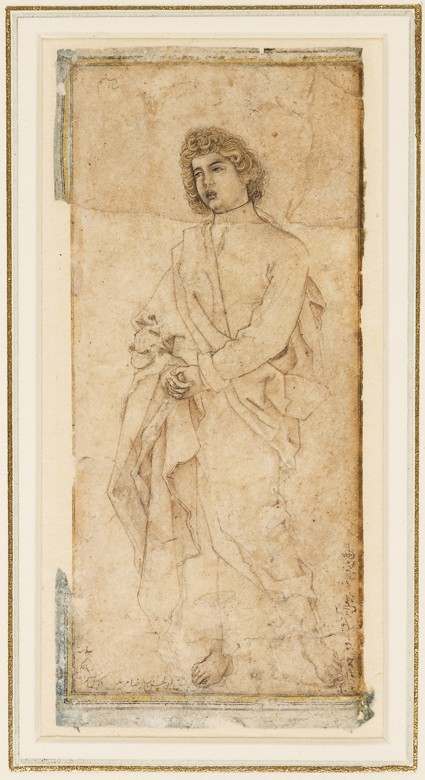Search Results: objects
Show search help- Reference URL
Actions
Saint John the Evangelist
-
Description
This drawing, after an engraving of the Crucifixion by Albrecht Dürer of 1511, is the earliest known work by the famous artist Abu’l Hasan, then aged twelve. It is already more of a creative reinterpretation of its original engraving than a mere copyist’s exercise. Within a few years, Abu’l Hasan’s refined naturalistic technique, together with his psychological insight, would make him the foremost portraitist at Jahangir’s court.
-
Details
- Associated place
-
Asia › India › north India (place of creation)
- Date
-
1600 - 1601 (AH 1009)
Mughal Period (1526 - 1858)
- Artist/maker
-
Abu 'l-Hasan (active 1589 - 1630) (artist)after Albrecht Dürer (1471 - 1528) (engraver)
- Associated people
-
Jahangir (ruled 1605 - 1627) (commissioner)
- Material and technique
- brush drawing with gouache on paper
- Dimensions
- 10 x 4.6 cm (height x width)
- Material index
- Technique index
- Object type index
- No. of items
- 1
- Credit line
- Gift of Gerald Reitlinger, 1978.
- Accession no.
- EA1978.2597
-
Further reading
Harle, J. C., and Andrew Topsfield, Indian Art in the Ashmolean Museum (Oxford: Ashmolean Museum, 1987), no. 84 on pp. 76-77, p. xiv, illus. p. 77
Topsfield, Andrew, Indian Paintings from Oxford Collections, Ashmolean Handbooks (Oxford: Ashmolean Museum in association with the Bodleian Library, 1994), no. 8 on p. 22, p. 6, illus. p. 23
London: Royal Academy of Arts, 1947-1948, The Art of India and Pakistan: A Commemorative Catalogue of the Exhibition Held at the Royal Academy of Arts, London, 1947-8, Leigh Ashton, ed. (London: Faber and Faber, 1950), no. 665 on p. 148, pl. 128
London: British Museum, 13 April-11 July 1976, Paintings from the Muslim Courts of India, R. H. Pinder-Wilson, Ellen Smart, and Douglas Barrett, eds (London: World of Islam Festival Publishing, 1976), no. 87 on p. 61
Wellesz, E. F., ‘Mughal Paintings at Burlington House’, The Burlington Magazine, 90/539, (1948), p. 46, fig. 25
Skelton, R., ‘Europe and the Courts of India’, Europa und die Kunst des Islam, 15. bis 18. Jahrhundert [= Europe and the Art of Islam, 15th-18th Century], Akten des XXV Internationalen Kongresses für Kunstgeschichte [= Files of the XXV International Congr (Vienna: H. Böhlaus Nachf., 1985), pp. 35-36
London: British Museum, 5 December 2002-23 March 2003, Albrecht Dürer and his Legacy: The Graphic Work of a Renaissance Artist, Giulia Bartrum and others, eds (London: British Museum, 2002), no. 217 on p. 263
Guy, John, and Britschgi, Jorrit, Wonder of the Age: Master Painters of India, 1100-1900. (New York: Metropolitan Museum of Art and New Haven: Yale University Press, 2011), no. 28 on p.74
Location
-
- currently in research collection
Objects are sometimes moved to a different location. Our object location data is usually updated on a monthly basis. Contact the Jameel Study Centre if you are planning to visit the museum to see a particular object on display, or would like to arrange an appointment to see an object in our reserve collections.
Publications online
-

Indian Art in the Ashmolean Museum
This small and unusually expressive rendering of the figure of St. John from the engraving of Crucifixion in Albert Dürer’s Passion series of 1500 is the earliest known work by Abū’l Hasan, one of the most favoured artists of the emperor Jahāngīr (r.1605-27). An even keener connoisseur of painting than his father Akbar, Jahāngīr admired above all Abū’l Hasan’s brilliantly naturalistic technique and the sympathetic insight of his portraiture. In 1618 he wrote of the artist, “at the present time he has no rival or equal”, and he bestowed on him the title “Wonder of the Age”
The son of the distinguished Persian painter Aqā Rizā, Abūl Hasan had grown up in the service of Prince Salīm (the future Jahāngīr). This drawing was executed in October 1600, when Salīm was already in revolt against the ageing Akbar and, as the Persian inscription tells us, Abūl Hasan himself was only twelve years old (in his “thirteenth year”). The copying of European prints played an important part in the training of Mughal artists at this time. But Abūl Hasan’s dextrous reinterpretation of the figure of the Evangalist is more than a technical exercise. Mr Robert Skelton has recently written of it, “… for a copy, particularly from one medium to another, it is a remarkable achievement. Working with a more subtle instrument than the graver’s burin, the young Indian has substituted for Dürer’s accomplished rendition of conventional saintly grief, a troubled expression of inner disquiet, which is all the more exceptional in that introspection of this sort is totally foreign to either Indian or Iranian art.”
Collection trails
© 2013 University of Oxford - Ashmolean Museum


